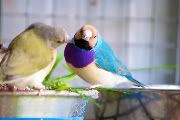To bald or not to bald
- vettepilot_6
- ^^^^^^^^^^^^^^

- Posts: 2826
- Joined: 07 Aug 2011, 17:50
- Location: Childers
- Contact:
Could be lacking in diet...Goulds require Iodine more so then other finches..
The Bitterness of Poor Quality Remains Long after the Sweetness of Cut Price is Forgotten
- spanna
- ...............................

- Posts: 1071
- Joined: 03 Jun 2010, 16:03
- Location: Bullsbrook, Western Australia
- Contact:
Interesting question brooksy. I can't provide a hard and fast answer, but I would say they are for the most part plucked by other, more dominant, birds. I have 2 pairs in one aviary, the hens are sisters (from the same nest), and the cocks are brothers. One hen is a bit of a vulture, while the other is in perfect feather. Both the males are also in perfect feather, and all birds have bred... They all have the same diet, exact same nest boxes and all. 
- Brooksy
- ...............................

- Posts: 508
- Joined: 14 Mar 2010, 18:59
- Location: Ocean Grove VIC
My situation is similar, although the hens are unrelated. The RH hen looks terrible when she is breeding but the BH hen looks as good as the RH & BH cock birds.spanna wrote:Interesting question brooksy. I can't provide a hard and fast answer, but I would say they are for the most part plucked by other, more dominant, birds. I have 2 pairs in one aviary, the hens are sisters (from the same nest), and the cocks are brothers. One hen is a bit of a vulture, while the other is in perfect feather. Both the males are also in perfect feather, and all birds have bred... They all have the same diet, exact same nest boxes and all.
- SamDavis
- ...............................

- Posts: 2578
- Joined: 03 Jan 2011, 14:01
- Location: Douglas Park NSW
I've often heard that plucking is blamed for this condition however I doubt that this is the case. Normally plucked birds are bald behind the head and down betweeen the wings. In extreme plucking cases the plucking moves over the top of the skull towards the beak. In baldy gouldians the baldness is different. in gouldians I've encountered the entire head can be completely bald including around the ears and under the beak. but not behind the head or down between the wings. Until this year I've only ever had it happen with breeding birds (normally hens) and I always cull them, but earlier this year I swapped 5 gouldians with a buyer who bought 5 pairs of gouldians off me. I intended to keep 1 and use the rest to make up unrelated pairs to sell. Anyway I've got three of these (all cocks) left and they all show signs of baldness yet they've just been sitting in my holding cage. There's a few other unrelated gouldians in with them and they all seem to be in fine feather. When I first got them I did notice the odd missing head feather so I sprayed them for mites but they have continued to get worse. The only conclusion is that it's an inherited genetic condition and maybe these guys are double factor baldies!
- vettepilot_6
- ^^^^^^^^^^^^^^

- Posts: 2826
- Joined: 07 Aug 2011, 17:50
- Location: Childers
- Contact:
A compressed molt ( breeding starts too close to the end of the natural molt season) is the most likely cause of baldness, whereas poor nutrition (lack of Iodine) associated with a sudden cold spell or disease process is the likely cause of missing facial feathers and head pin feathers. Also the appearance of multiple pin feathers crowding a Gouldian's head is an indication of a sudden halt to the molt as a result of an energy and protein deficiency.
The Bitterness of Poor Quality Remains Long after the Sweetness of Cut Price is Forgotten
- Myzomela
- ...............................

- Posts: 1545
- Joined: 24 Jan 2011, 18:44
- Location: Melbourne Vic
Mike Fidler believes it is genetic and he culls hens which show this trait.
Many also have secondary skin infections eg fungal.
We are currently assessing these cases by taking skin biopsies from affected birds, then exposing them to controlled stressful environments and noting whether the baldness improves, gets worse or remains the same.Various hormones will be measured during these times. This is part of a collaborative research project with Sarah Pryke and Charles Sturt University.
The results are not through yet but should be very interesting.
Many also have secondary skin infections eg fungal.
We are currently assessing these cases by taking skin biopsies from affected birds, then exposing them to controlled stressful environments and noting whether the baldness improves, gets worse or remains the same.Various hormones will be measured during these times. This is part of a collaborative research project with Sarah Pryke and Charles Sturt University.
The results are not through yet but should be very interesting.
Research; evaluate;observe;act
- Myzomela
- ...............................

- Posts: 1545
- Joined: 24 Jan 2011, 18:44
- Location: Melbourne Vic
...Or any other interruption to the growth and maturation of feathers such as concurrent illness, stress or other nutrient deficiencies.vettepilot_6 wrote:Also the appearance of multiple pin feathers crowding a Gouldian's head is an indication of a sudden halt to the molt as a result of an energy and protein deficiency.
I am sure we will have more answers to these questions with ongoing research.
Research; evaluate;observe;act
- gouldianpaul
- ...............................

- Posts: 804
- Joined: 21 Oct 2010, 14:26
- Location: melbourne
Hi Myzomela,
It would be great if the findings of this research was made avaiable to the AFF...cheers, Paul
It would be great if the findings of this research was made avaiable to the AFF...cheers, Paul

